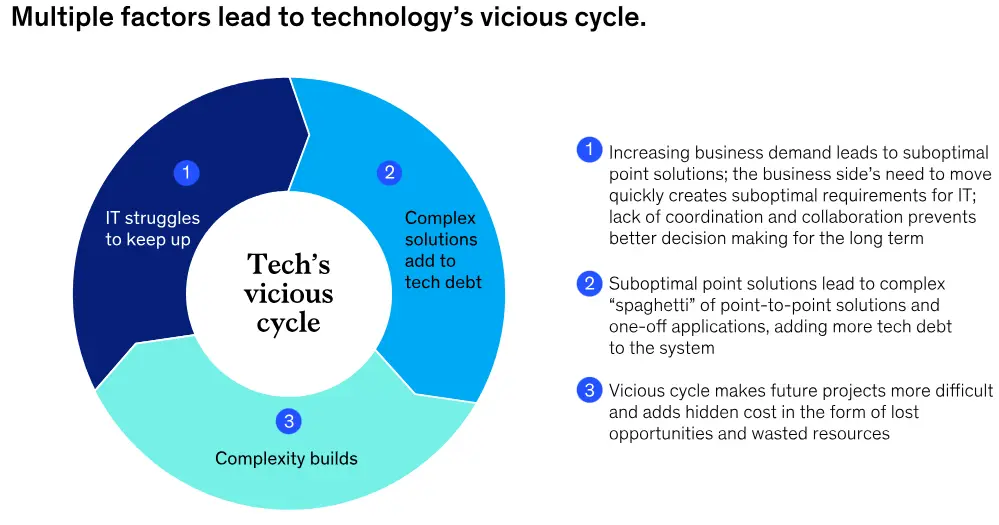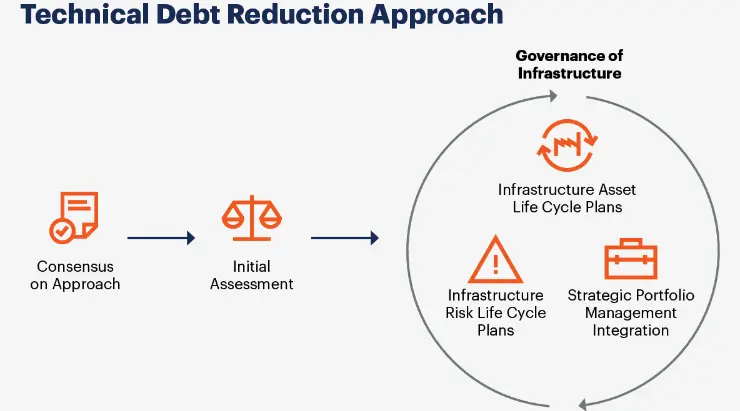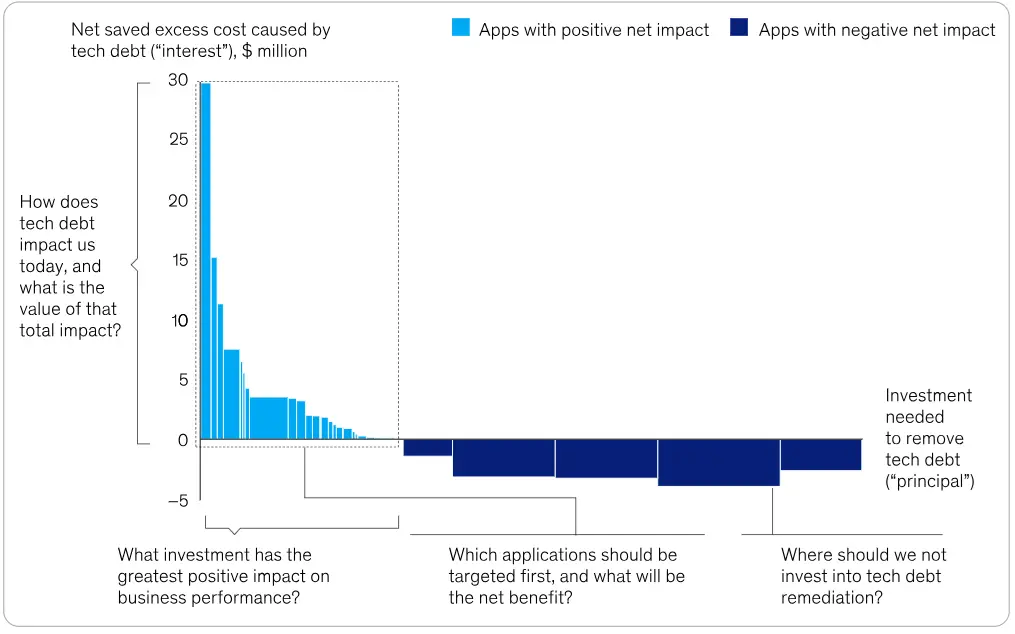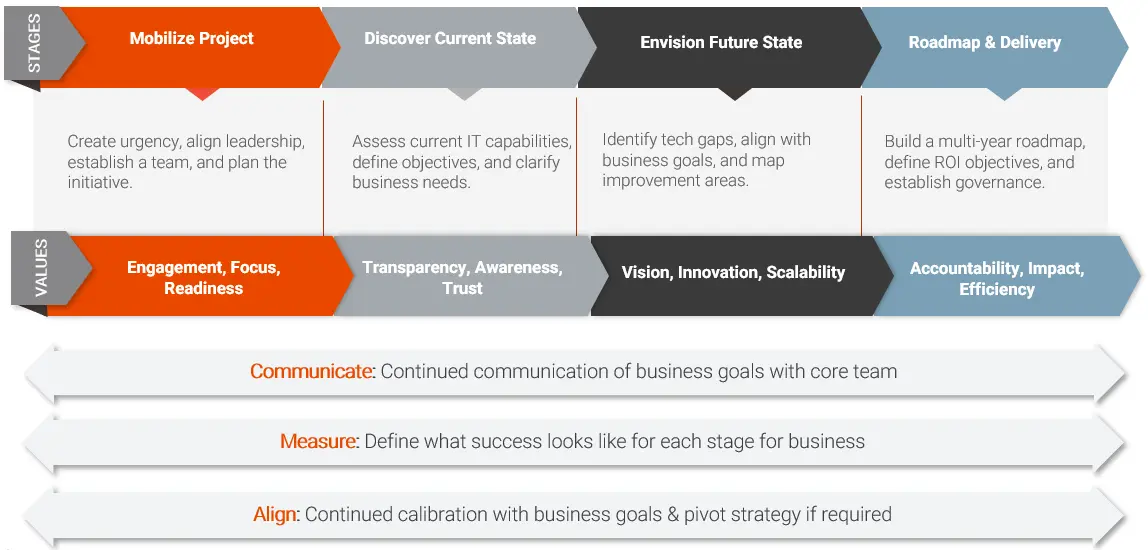August 30, 2024 - by Manan Thakkar
Technology has become synonymous with business. Every organization is adopting the latest technology innovations to survive and thrive. Analysts project that global tech spending will grow by 5.3% in 2024, reaching $4.7 trillion. This growth is leading to the introduction of new-age tools and solutions in the enterprise ecosystem. However, this widespread and massive tech adoption also leads to the inevitable challenge of technical debt.
Understanding the financial implications of technical debt is crucial for effective planning and strategic decision-making. Since poor debt management can have several repercussions, including increased operational costs, delayed time to market, higher risk, etc., CFOs and other C-suite executives must take the right strategic steps.
Building your 2025 Technology Strategy and Plan? We can Help!
Evaluating the Impact of Technical Debt
In today’s age of digitalization, organizations are under extreme pressure to embrace the latest technological advancements. However, tight deadlines and volatile market conditions force organizations to take shortcuts.
Many organizations compromise several critical steps in the software development process. They ignore coding standards, skip essential testing steps, and hurry up on documentation. Such sacrifices to meet delivery deadlines cause software products to deviate from their intended functionality.
On the one hand, where businesses need resistant and flexible infrastructure, uncontrolled debt makes resilience and adaptability difficult. According to a study by the Wall Street Journal, global technical debt would require $1.52 trillion to fix, costing the U.S. $2.41 trillion a year in cybersecurity and operational failures, failed development projects, and maintenance of outdated systems.

Source: McKinsey
In the long run, these workarounds can impact the system’s performance, scalability, security, etc. When not addressed in time, technical debt can lead to several far-reaching consequences for businesses:
Inability to Effectively and Efficiently Adopt Modern Technical Solutions
High technical debt can significantly hinder the adoption of modern technical solutions. Legacy code, resource constraints, and integration issues cause organizations to spend much more time managing and optimizing existing systems. This distracts them from implementing and integrating new tools and solutions, impacting performance, scalability, and stability.
Increased Business Risk Due to Poor Business Agility
Technical debt slows development, causing delays in launching new products or features. This makes meeting market deadlines and customer expectations difficult, resulting in lost market opportunities and reduced competitiveness while reducing business agility and stifling innovation.
Potential for Significant Unplanned Expenses
Technical debt can cause organizations to spend more money on managing and maintaining their systems. Identifying and managing defects and inefficiencies demands significant time and effort while compelling teams to implement urgent patches as emergency fixes. System downtime is also expected when high debt impacts user experience and business performance.
Identifying Reasons for Technical Debt
When unchecked, technical debt can cause the software to become unstable or even unusable, causing severe customer dissatisfaction. Here are three primary reasons that lead to uncontrollable debt:
- Lack of IT planning is one of the most common causes of technical debt.
Many organizations adopt new tools and systems without considering their necessity or potential benefits to their business. They often fail to evaluate whether these tools will add value to their operations. This lack of foresight can lead to wasted resources and inefficiencies in the long run.
Organizations must carefully assess the relevance and impact of new tools before implementing them. When business and tech goals do not match, this can lead to inefficiencies, missed opportunities, and conflicts, hindering the organization’s growth and competitiveness.
- Lack of non-IT awareness is another major factor that causes technical debt.
Most non-IT teams do not understand debt or how it impacts the business’s day-to-day functioning. This can lead to higher operational costs while limiting agility and scalability. Not being aware can lower product quality, put the organization at risk, and cause problems with following rules. It can also make the customer experience worse.
- Aversion to change is a widespread reason many organizations end up with uncontrolled technical debt.
Recognizing the signs and causes of debt can be overwhelming. Setting coding and review standards and developing long-term strategies and roadmaps might seem daunting. Assigning new resources, training team members, monitoring progress, etc., impacts daily operations, hindering teams from entirely focusing on overcoming debt.
3 Steps for Proactive Management
Organizations must address their technical debt and take proactive measures to prevent further debt accumulation.

Source: Gartner
Here are key strategies and steps for proactive technical debt management:
1. Establish a Tech Governance Program
Establishing a robust tech governance program is the first step to combating technical debt. A good governance plan outlines how to use, manage, and monitor tech resources and includes other important details.
- Measure and track KPIs such as code duplication, test coverage, and mean time to resolve incidents to minimize debt and improve ROI.
- Strengthen the incident response plan to identify and contain debt issues, build trust and compliance, and enable high levels of transparency and visibility.
- Enable continuous monitoring of the technology landscape to find and track weaknesses as threats and the environment change.
2. Enable Long-Term Technical Debt Management
Organizations looking to manage technical debt proactively must also move beyond short-term hacks. Instead, they must allocate 60% of their technical governance discussions to long-term planning and debt management.
- Take an agile development approach to enable rapid development while minimizing technical debt gradually with each consequent sprint.
- Enable application modernization to move away from monolithic architectures and rigid codebases and improve performance and efficiency.
- Ensure infrastructure and platform lifecycle management, especially for aging hardware and systems.
- Follow coding rules and test software periodically to minimize existing debt and avoid accruing future debt.

Source: McKinsey
3. Ensure Annual Budgeting Includes Time and Expenses Against Managing Technical Debt
Organizations must set aside money for regular assessments, audits, training, governance, and automation to address debt effectively. Allocating funds for these activities is crucial to managing technical debt effectively.
- Include time and expenses for managing technical debt in the annual budget to maintain healthy, stable, and scalable software systems.
- Conduct detailed cost-benefit analyses and share outcomes with leaders to justify the necessity of budget allocation for managing debt.
- Demonstrate potential savings and reduce risks.
Fuel Long-term Business Growth and Success with the Right Approach
As technology forms the backbone of most organizations, technical debt is becoming widespread. Addressing debt early is essential to prevent future problems, even though eliminating it may seem challenging. Tackling debt as soon as possible is necessary to avoid complications.
A holistic approach can ensure the financial, operational, and strategic dimensions of technical debt management are addressed. Allocating sufficient budget, prioritizing investments, and regularly monitoring and reviewing IT infrastructure, software, and systems can enable CFOs and other C-suite executives to ensure their technology systems’ strength, ease of maintenance, and scalability. This is crucial for supporting the business’s long-term success while paving the way for sustainable growth in an increasingly digital marketplace.
About the Author
Manan Thakkar is the Director of Consulting at Synoptek. An IT professional with strong technical, analytical, and administrative skills and a self-motivated and energetic performer, Manan has a strong hold on designing systems for Cloud, Enterprise Mobility, Finance, and Risk sectors. He exudes expert consulting skills in creating sales pipelines, building strategic roadmaps, handling client discovery, and managing risk and compliance.





